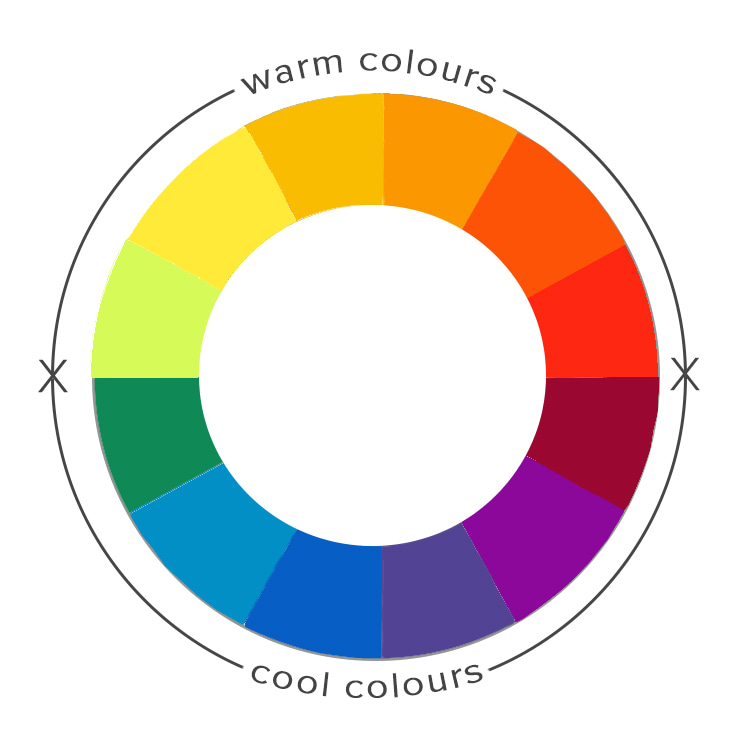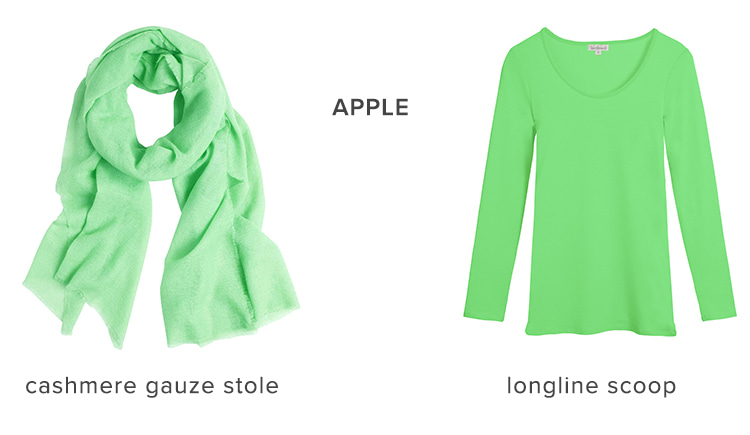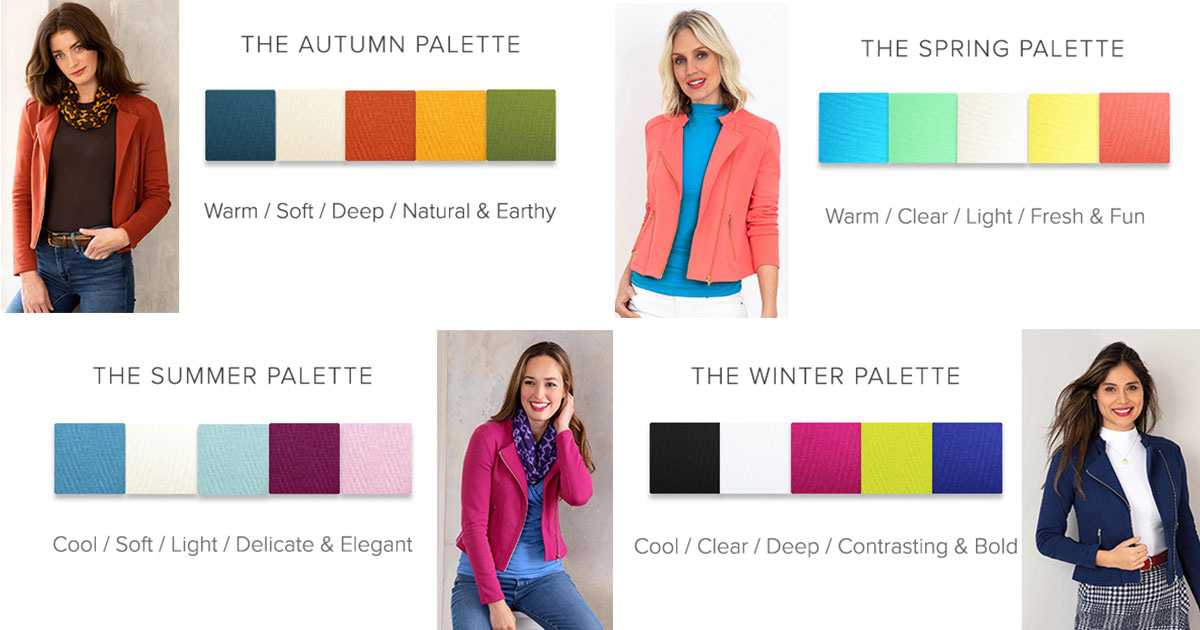Your colour masterclass
You might just have noticed that we quite like colour here. Actually, we're pretty obsessed with it in every last glorious hue; delicate to strong, cool to warm, light to dark, muted to bold and any other colour-related scale of reference you can come up with.
But when we talk about a colour as cool, light or muted, what exactly do we mean? I've put together a whistle stop masterclass in how colour works and what that means for the colours you look and feel your best in.
Relative temperature
When we consider a colour, the first thing we want to think about is its relative temperature.

In very basic terms, half of all colours are warm, and half are cool. But although this very basic colour theory is a good place to start, we need to think about relative temperature, not just whether a colour is yellow or blue or green. We know that the more yellow a colour has in it, the warmer it is, the more blue it has, the cooler it is. So what happens when you add more yellow to that coolest of blues, for instance? Add enough and it will shift into being a warm shade. Make that yellow so sharp and acidic that it has lost all of its golden warmth, add a hint of blue to make it extra neon, and suddenly you're looking at a much cooler version of this warmest of shades.

So when you're looking at colour, think of its relative temperature, rather than just the basic colour. Is it a red with more yellow, or more blue in? You'll soon notice that colours with a fairly equal balance (like teal, and many taupe shades) tend to fall somewhere in the middle, and will harmonise with almost any colour as well as suiting a wide range of skintones. These are our universal colours at Kettlewell, and we love them as a first step into colour for those who aren't sure what works for them.
Value
The second attribute of a colour we need to consider is its value. This is a simple way of saying how dark or light it is. The more white a colour has in its make up, the lighter it will be; more black means a deeper darker colour.

Generally, the more depth of colour you have in your natural colouring, the more depth of colour you can take in your clothes (this is not an absolute rule, as we'll see in a moment when we come to consider contrast), but we have all seen, for instance, how harsh and stark black can look on someone with very pale hair, skin and eyes, compared to the elegant intensity it can have on someone with much deeper colouring.

As a general rule, as we age it becomes more challenging to wear the deepest colours within our palette. Black becomes harder and harder to pull off, and a deep grey or navy is likely to be much more flattering. More unexpectedly, a bold bright pink might be kinder than a heavy burgundy (on someone whose palette holds both of those colours), despite the brightness of the shade.
Brightness/intensity
As well as depth of colour, we want to think about how bright a colour is. This means whether it is clear and bright, or has been muted down with the addition of grey.

Someone who suits clear, bright, fresh colours will look tired and dull in the more muted shades, whereas those bold shades will completely overwhelm someone who needs a softer look.
Colour analysis systems divide colours up into four seasonal palettes, two bright and two muted, but even within one palette there can be a surprising degree of shift from soft to bright - this reminds us that colour is a spectrum rather than a set of four neat boxes.

Contrast
Contrast is the difference between colours we wear, or the difference between those colours and our own skintone, hair and eyes. It is so important in affecting how colours look, and applies within the contrast level between colours we wear, as well as their contrast with our own skin tone.

Different people will suit different levels of contrast - some people can go as extreme as true black and white, or hot pink and bright blue, while others look fabulous in a tonal outfit of mid-grey and denim blue. In the image above, Marija our summer model suits low contrast, so although she is wearing colour, none of them are wildly stand out, rather the whole outfit is tonal and harmonious. Paula, on the other hand, suits colour blocking and high contrast, and would look boring in a tonal muted outfit.
Even when it comes to your best colours, wearing them in a way which isn't your best in contrast terms can really impact how good they look. Someone who needs muted colours and low contrast, for instance, will look much more severe if they colour block with only the lightest and darkest colours from their palette - this might only feel appropriate in an very formal environment (and might be even better with a slightly lower contrast equivalent), whereas someone who suits high contrast would look amazing in this combination for casual too.
Texture
Texture isn't exactly an aspect of colour, but it's something that does affect the way we perceive it, so it's worth mentioning here. The more textured a fabric is, the softer and more muted a colour looks. Smooth and shiny fabrics make the colours look instantly brighter.

An understanding of texture can be helpful if you're pushing the limits of your best colours. For someone who suits bright colours, for instance, a colour that is at the very softest end of their personal palette will be much improved if it's in a silk or another somewhat light reflecting fabric, whereas that same colour in suede or velvet might feel very drab and flat and like it belongs to another palette.
Which colours are for me?
And of course, the most important question of all is, which colours work for me? In the colour analysis world, we divide up all colours according to the attributes above, and place them into four seasonal palettes, Spring, Summer, Autumn and Winter.
The seasons are each summarised below, but be aware these are just broad summaries - remember that colour is a spectrum rather than four distinct categories, and there will be outliers within each season (for instance, you might be a Spring who suits the very lightest, softest and coolest end of your palette, but nonetheless are very much a Spring rather than a Summer). If you occasionally see a Kettlewell colour and feel that it doesn't belong in your palette, it can be worth considering whether it falls at a different 'end' of the palette to the one where your skintone lives. You can learn more about the different types within each season and how they wear their colours in this blog post.

Autumn - warm, rich, muted colours. Colours tend not to get too light, and Autumns usually suit a tonal look in mid-range to deeper colours.
Spring - warm, clear, bright colours, a light season on the whole. Reasonably high contrast although the colours never get as dark as black or true navy.
Summer - cool, soft, muted colours. Colours can vary from very deep to very pale, but most Summers look best in more tonal outfits rather than pairing their lightest and deepest shades together.
Winter - cool, bright, high contrast colours. Winters usually look their best in looks which combine the very darkest and lightest colours in their palette, or neutrals with a splash of intense brightness, to give them that contrast that works so well.
If you want to discover which palette of colours belongs to you - whether you need bright or soft, warm or cool, high or low contrast - then our colour quiz is a great place to start. And if you want more information, you can get a definitive answer by booking a personal colour analysis; you can find a colour stylist here.


Anne Morrissey on Feb 08, 2023 9:57 AM
I’m a cool summer, so, when I choose a cool summer coloured item from the Kettlewell site the info below can sometimes suggest the item colour is also suitable for I.e, winter & spring, why is this so?
Helen Brooks on Nov 16, 2021 8:52 AM
This is so helpful. I have been grappling with these concepts - cool/warm, contrast, tonality - for some time and making mistakes along the way. I understand more now, and am having a proper analysis soon which will be illuminating.
Janet Prager on May 30, 2020 12:25 PM
This is an extremely interesting and informative article. Thank you.
Vivien on Jan 29, 2020 8:10 PM
I am a sprinter winter, which colours can I wear with my new pop of acid yellow t-shirt please
Kettlewell Colours: Our Sprinter Winter suggests Pine, Navy, Chinese Blue, Silver, Ice Blue or Lavender. (I like Lobelia with Acid Yellow but then I'm a Jewel Winter!)
Norma Hughes on Oct 19, 2019 9:48 AM
Hi Jo, I am a summer palette and have bought 3 Lulu tops ( dolphin grey, heliotrope and deep teal). I would like to but an infinity scarf . Can you suggest any colours that would team up with 2 or even all 3 . Thanks
Kettlewell Colours: We had fun checking this out! Unexpectedly, Hawaii looked good with all three or Dolphin Grey would match the Dolphin Grey Lulu and look nice with the other two colours.
Barbara on Jul 26, 2019 10:40 AM
Revisiting this blog the section on texture really struck a chord. Definitely something to consider when we buy knitwear next season.
Kathy on Apr 08, 2019 10:00 PM
Re-reading this, I was surprised to see Pink Ice shown as a muted pink. I have always understood it to be an 'icy' version of pink, very pale but very clear, and so suitable for a Winter (cool and clear)---as opposed to something like a powder pink, which is a softer, more greyed colour that would work for a Summer (cool and soft).
Sue on Apr 04, 2019 1:27 PM
Thank you Jo, that is extremely interesting and informative.
Sue Bailey on Apr 01, 2019 10:23 AM
I have been analysed as a Soft Blue Autumn having previously been a Soft Warm Autumn. Can you advise on some of the colours I should now be wearing? I'm finding it quite difficult to get away from the strong rusts and browns which now definitely do not suit me.
Many thanks
Kettlewell Colours: If you read this blog post
https://www.kettlewellcolours.co.uk/seasonal-blog/2018/the-seasonal-sub-types-autumn
it explains the different types of Autumns and advises colours which are suitable for each type. Hope this helps.
Kathy on Mar 28, 2019 4:01 PM
Even though I understand the colour system pretty well by now, the effect of texture is a new idea Fascinating to realise that more texture 'softens' a colour, while a flat or shiny texture will sharpen it.
I find these blog posts so helpful. Whether you are talking about colour theory, or how to combine various Kettlewell garments, or special aspects of each palette, I always enjoy and learn from them. Thank you!
Annie on Mar 27, 2019 2:46 PM
Good article but have never decided if I am summer or winter!
Alison Marsh on Mar 27, 2019 1:49 PM
I am definitely yellow based. however as I 've got older I feel that I can take on more colour and some brighter colours. I am not sure if I've moved to Spring or Summer colours. I feel the muted colours are getting bit dull on me.
Sian Davies on Mar 27, 2019 11:11 AM
Excellent blog well done. Loved the pictures as they clearly show how the same colour can look different in different fabrics.